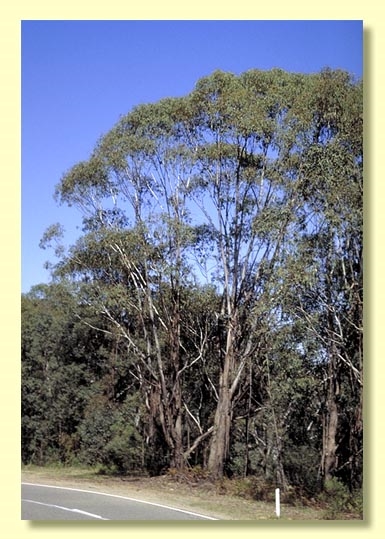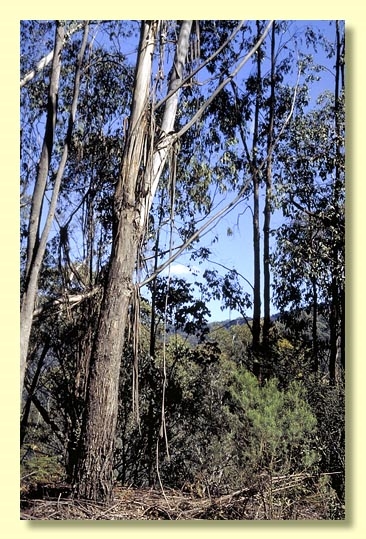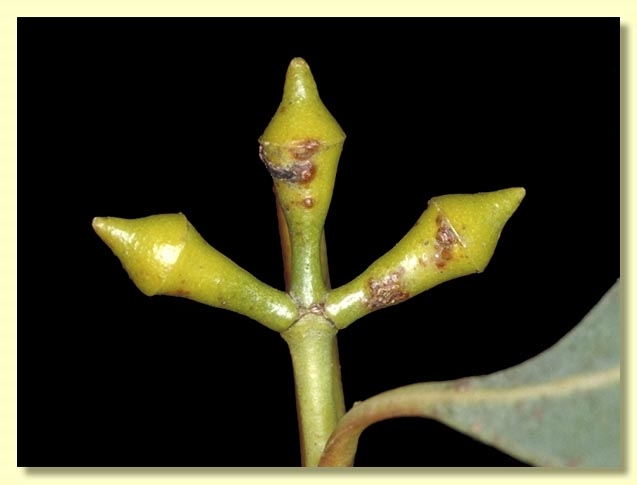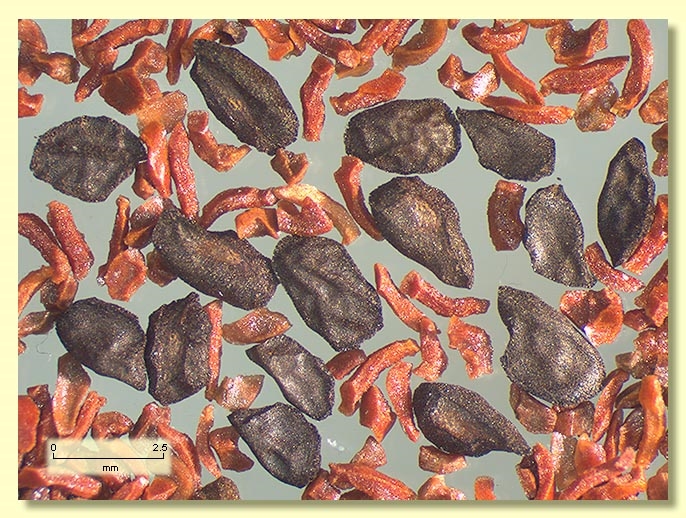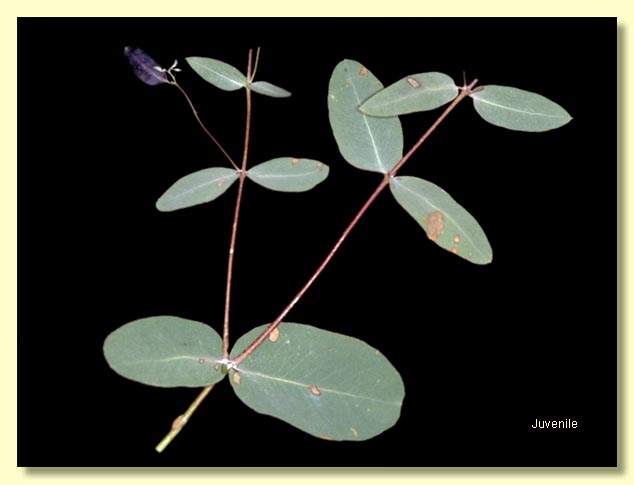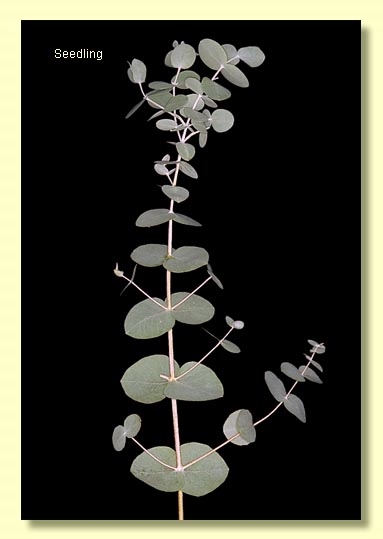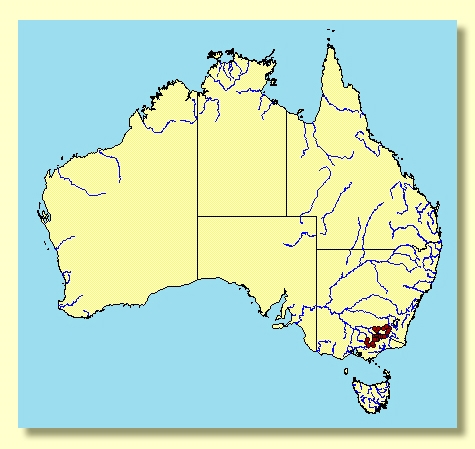Euclid - Online edition
Eucalyptus chapmaniana
Classification
Eucalyptus | Symphyomyrtus | Maidenaria | Euryotae | Orbiculares
Nomenclature
Eucalyptus chapmaniana Cameron, Victorian Naturalist 64: 52 (1947).
T: State Electricity Commission private road to Pretty Valley, 2–3 miles [c. 3–5 km] above Bogong, Vic., 2 Mar. 1947, A.K.Cameron s.n.; holo: MEL; iso: BRI, K.
T: State Electricity Commission private road to Pretty Valley, 2–3 miles [c. 3–5 km] above Bogong, Vic., 2 Mar. 1947, A.K.Cameron s.n.; holo: MEL; iso: BRI, K.
Description
Tree to 35 m tall. Forming a lignotuber.
Bark on trunk partly or completely rough, fibrous and finely fissured longitudinally grey or brown-grey, branches smooth, light brown to creamy-white or pale grey, with long ribbons of decorticated bark in the branches, branchlets sometimes glaucous.
Juvenile growth (coppice or field seedlings to 50 cm): stem rounded in cross-section, glaucous or non-glaucous; juvenile leaves opposite and sessile for many pairs, orbicular to ovate, 2–9.5 cm long, 1.8–7 cm wide, margin entire or occasionally crenulate, green, blue-green or slightly glaucous.
Adult leaves alternate, petiole 1.3–3.7 cm long; blade lanceolate to falcate, 14–30 cm long, 1.7–4.8 cm wide, base tapering to petiole, concolorous, dull, green to blue-green, side-veins greater than 45° to midrib, moderately to densely reticulate, intramarginal vein parallel to and just within margin, oil glands mostly island.
Inflorescence axillary unbranched, peduncles 0.5–0.9 cm long, buds 3 (rarely 7) per umbel, pedicels 0.2–0.3 cm long. Mature buds clavate or diamond-shaped, 0.7–0.9 cm long, 0.5–0.6 cm wide, green to yellow or glaucous, scar present, operculum conical to beaked, stamens inflexed, anthers cuboid or cuneate, versatile, dorsifixed, dehiscing by longitudinal slits (non-confluent), style long, stigma blunt or tapered, locules 3 or 4, the placentae each with 4 vertical ovule rows. Flowers white.
Fruit sessile or on pedicels to 0.3 cm long, obconical or campanulate, 0.5–0.9 cm long, 0.7–1 cm wide, usually glaucous, disc conspicuously raised and convex, vertical or oblique, valves 3 or 4, exserted.
Seeds black, brown or grey, 1–3 mm long, flattened-ovoid, often pointed at one end, usually lacunose, dorsal surface smooth, hilum ventral.
Cultivated seedlings (measured at ca node 10): cotyledons bilobed; stems rounded in cross-section, slightly warty, usually glaucous; leaves sessile, opposite for many pairs, orbicular to cordate, 1–6 cm long, 0.5–5.3 cm wide, base rounded to tapering, margin entire or subcrenulate, apex rounded to pointed, glaucous or grey-green.
Bark on trunk partly or completely rough, fibrous and finely fissured longitudinally grey or brown-grey, branches smooth, light brown to creamy-white or pale grey, with long ribbons of decorticated bark in the branches, branchlets sometimes glaucous.
Juvenile growth (coppice or field seedlings to 50 cm): stem rounded in cross-section, glaucous or non-glaucous; juvenile leaves opposite and sessile for many pairs, orbicular to ovate, 2–9.5 cm long, 1.8–7 cm wide, margin entire or occasionally crenulate, green, blue-green or slightly glaucous.
Adult leaves alternate, petiole 1.3–3.7 cm long; blade lanceolate to falcate, 14–30 cm long, 1.7–4.8 cm wide, base tapering to petiole, concolorous, dull, green to blue-green, side-veins greater than 45° to midrib, moderately to densely reticulate, intramarginal vein parallel to and just within margin, oil glands mostly island.
Inflorescence axillary unbranched, peduncles 0.5–0.9 cm long, buds 3 (rarely 7) per umbel, pedicels 0.2–0.3 cm long. Mature buds clavate or diamond-shaped, 0.7–0.9 cm long, 0.5–0.6 cm wide, green to yellow or glaucous, scar present, operculum conical to beaked, stamens inflexed, anthers cuboid or cuneate, versatile, dorsifixed, dehiscing by longitudinal slits (non-confluent), style long, stigma blunt or tapered, locules 3 or 4, the placentae each with 4 vertical ovule rows. Flowers white.
Fruit sessile or on pedicels to 0.3 cm long, obconical or campanulate, 0.5–0.9 cm long, 0.7–1 cm wide, usually glaucous, disc conspicuously raised and convex, vertical or oblique, valves 3 or 4, exserted.
Seeds black, brown or grey, 1–3 mm long, flattened-ovoid, often pointed at one end, usually lacunose, dorsal surface smooth, hilum ventral.
Cultivated seedlings (measured at ca node 10): cotyledons bilobed; stems rounded in cross-section, slightly warty, usually glaucous; leaves sessile, opposite for many pairs, orbicular to cordate, 1–6 cm long, 0.5–5.3 cm wide, base rounded to tapering, margin entire or subcrenulate, apex rounded to pointed, glaucous or grey-green.
Flowering Time
Flowering has been recorded in January, February and March.
Notes
Eucalyptus chapmaniana is an uncommon small to medium-sized tree sporadically distributed in montane and subalpine eastern Victoria and far south-eastern New South Wales.
E. chapmaniana is distinguished from other common 3-budded species in the mountain forests, viz. E. globulus subsp. bicostata, E.dalrympleana, E. rubida and E. viminalis, by the rough bark over most of the trunk, smooth branches shedding bark in very long ribbons, and bluish green crown. It has the opposite, orbicular to ovate seedling leaves of E. rubida and E. dalrympleana which further distinguish it from E. viminalis, which is more likely to occur in valleys than on well-drained slopes preferred by E. chapmaniana. It differs from E. glaucescens in having a more obconical fruit with a conspicuous raised disc and exserted valves.
Eucalyptus chapmaniana belongs in Eucalyptus subgenus Symphyomyrtus section Maidenaria, a large group of species more or less restricted to south-eastern Australia, characterised by bilobed cotyledons, simple axillary inflorescences, buds with two opercula, stamens with versatile anthers and flattened seeds with a ventral hilum. Within this section, E. chapmaniana, with nine other species, forms series Orbiculares having orbicular to ovate juvenile leaves opposite for many nodes, a blue-green crown, buds in threes. Series Orbiculares is confined to far south-eastern New South Wales, eastern Victoria and Tasmania.
E. chapmaniana is distinguished from other common 3-budded species in the mountain forests, viz. E. globulus subsp. bicostata, E.dalrympleana, E. rubida and E. viminalis, by the rough bark over most of the trunk, smooth branches shedding bark in very long ribbons, and bluish green crown. It has the opposite, orbicular to ovate seedling leaves of E. rubida and E. dalrympleana which further distinguish it from E. viminalis, which is more likely to occur in valleys than on well-drained slopes preferred by E. chapmaniana. It differs from E. glaucescens in having a more obconical fruit with a conspicuous raised disc and exserted valves.
Eucalyptus chapmaniana belongs in Eucalyptus subgenus Symphyomyrtus section Maidenaria, a large group of species more or less restricted to south-eastern Australia, characterised by bilobed cotyledons, simple axillary inflorescences, buds with two opercula, stamens with versatile anthers and flattened seeds with a ventral hilum. Within this section, E. chapmaniana, with nine other species, forms series Orbiculares having orbicular to ovate juvenile leaves opposite for many nodes, a blue-green crown, buds in threes. Series Orbiculares is confined to far south-eastern New South Wales, eastern Victoria and Tasmania.
Origin of Name
Eucalyptus chapmaniana: after Wilfrid Dinsey Chapman (1891–1955). Wilfred Chapman had a long and distinguished career as an electrical engineer. He also had a keen interest in botany and was an associate of the Royal Society of Victoria. He was first to discover the tree which now bears his name.
Copyright © CANBR 2020, all rights reserved.

Web edition hosted at https://apps.lucidcentral.org/euclid
